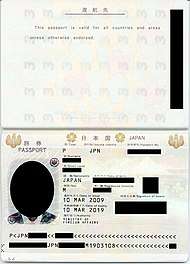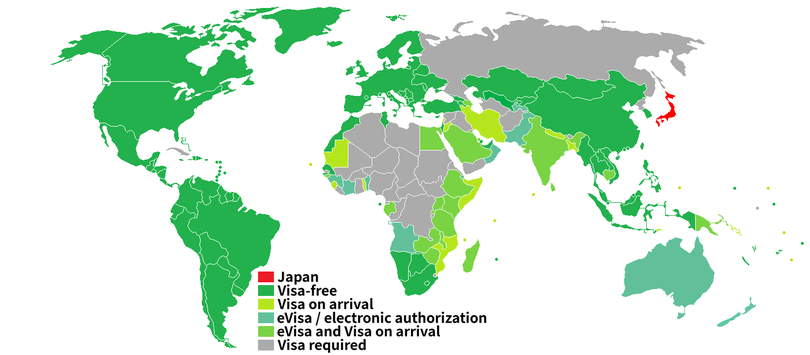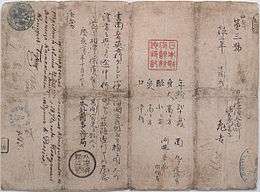Japanese passport
Japanese passports (日本国旅券, Nihonkoku ryoken) are issued to Japanese citizens to facilitate international travel.
| Japanese passport | |
|---|---|
The front cover of a contemporary 10 years Japanese ePassport. | |
 Identity Information Page of a 10 years Japanese biometric Passport. | |
| Type | Passport |
| Issued by | |
| First issued | 21 May 1866[1][lower-alpha 1] (letter of request) 1 January 1926[1] (booklet) 1 November 1992[1] (machine-readable passport) 20 March 2006[2] (biometric passport) 31 August 2013[3] (current version) |
| Purpose | Identification |
| Eligibility | Japanese citizenship |
| Expiration | 10 years or 5 years after acquisition for adults, 5 for ages under 19 |
| Cost | ¥16,000 (10 year adult passport) ¥10,000 (5 year passport)[4][5] |
History
The first travel documents for overseas travel by Japanese citizens were introduced in 1866, near the end of the Tokugawa shogunate. These documents took the form of a stamped "letter of request" allowing Japanese citizens to travel overseas for business and educational purposes. The term "passport" was formally introduced into the Japanese language in 1878, and in 1900 the first regulations governing the usage of Japanese passports were introduced. The modern form of the Japanese passport first came about in 1926, and the first ICAO-compliant, machine-readable Japanese passports were introduced in 1992.[1]
Types of passports
- Ordinary passport: Issued to normal Japanese citizens.
- Ordinary passports are issued in two different lengths of validity: 5 and 10 years. Japanese citizens up to 19 years of age can only be issued a 5 years passport, while those who are 20 years of age or older can choose either a 5 years (blue) or 10 years (red) passport for different registration fees.
- Official passport: Issued to members of the National Diet and public servants.
- Diplomatic passport: Issued to members of the Imperial Family, diplomats and their family members, and high-level government officials.
- By convention, the Emperor and Empress of Japan do not hold a passport.
- Emergency passport: Issued to overseas Japanese nationals when machine-readable passports are unable to be issued by a diplomatic mission of Japan due to a malfunction and there is no time to wait for the passport to be issued by the Ministry of Foreign Affairs of Japan, or to overseas Japanese nationals who failed to be issued a Travel Document for Return to Japan, valid for 1 year from date of issuance.
- Travel Document for Return to Japan (ja): Emergency single-use travel document issued to overseas Japanese nationals to return to Japan, features a white cover with the Paulownia Government Seal of Japan. Invalidated immediately after use.
All Japanese passports issued after 20 March 2006 are biometric passports.
Japanese passports have the Chrysanthemum Imperial Seal of Japan inscribed in the centre of the front cover, with the Japanese characters reading Nipponkoku Ryoken (日本国旅券) inscribed above in seal script and its English translation JAPAN PASSPORT in Latin letters below the Seal. Ordinary passports valid for five years feature dark blue covers, and those valid for ten years feature crimson-coloured covers. Additionally, official passports feature dark green covers, and diplomatic passports feature dark brown covers.
Data page
- Photo of the passport holder
- Type
- Issuing country
- Passport number
- Surname
- Given name
- Nationality
- Date of birth
- Sex
- Registered Domicile
- Date of issue
- Date of expiry
- Issuing authority
- Signature of bearer
The information page ends with the Machine Readable Zone.
Passport note
The passports contain a note from the issuing country that is addressed to the authorities of all other countries, identifying the bearer as a citizen of that country and requesting that he or she be allowed to pass and be treated according to international norms. The note inside of Japanese passports states:
In Japanese:
- 日本国民である本旅券の所持人を通路故障なく旅行させ、かつ、同人に必要な保護扶助を与えられるよう、関係の諸官に要請する。
In English:
- The Minister for Foreign Affairs of Japan requests all those whom it may concern to allow the bearer, a Japanese national, to pass freely and without hindrance and, in case of need, to afford him or her every possible aid and protection.
Language
Japanese passports are entirely printed in both Japanese and English, except for the note of caution that is found at the end of the passport (e.g. on page 51 of the ten-year biometric ordinary passport), which is only printed in Japanese. This note contains information about what the bearer should know when encountering various situations in a foreign country.
The surname, given name and other personalised mentions (like registered domicile) are only indicated in Latin uppercase letters. Japanese names are in principle transcribed according to the Hepburn romanisation system, but exceptions are admitted in certain cases, notably when the name is the katakana transcription of a foreign name (Japanese spouse or Japanese child of a foreigner), in which case the original spelling of the name in the Latin alphabet may be used, only if you submit the official document with the original spelling issued by the government (spouse or parent's passport etc.).
The signature may be written in any language and in any spelling the individual desires.
Visa requirements

Visa requirements for Japanese citizens are administrative entry restrictions by the authorities of other states which are placed on citizens of Japan. As of 3 April 2019, Japanese citizens had visa-free or visa on arrival access to 191 countries and territories, ranking the Japanese passport the strongest passport in the world in terms of travel freedom according to the Henley Passport Index.[6] However, suspension of visa waivers and travel restrictions toward Japanese passport holders since January 2020 due to the COVID-19 outbreak puts this fact into doubt.[7]
As of October 2018, the passports of Japan, Brunei, Singapore and San Marino are the only ones to allow either visa-free entry or electronic travel authorisation to the world's four largest economies, namely China, India, the European Union and the United States.
Gallery of Japanese passports
 First Japanese passport, issued in 1866.
First Japanese passport, issued in 1866. Japanese passport issued to Denjū Horiuchi (ja) in 1903.
Japanese passport issued to Denjū Horiuchi (ja) in 1903. Imperial Japanese Overseas Passport issued in Taiwan in 1917.
Imperial Japanese Overseas Passport issued in Taiwan in 1917. Restricted passports for passengers travelling between Mainland Japan and Okinawa during 1952-1972.
Restricted passports for passengers travelling between Mainland Japan and Okinawa during 1952-1972. Front cover of a non-machine-readable Japanese passport issued in the 1980s.
Front cover of a non-machine-readable Japanese passport issued in the 1980s. 5 year validity Japanese ePassport.
5 year validity Japanese ePassport. Japanese official passport.
Japanese official passport.- Travel Document for Return to Japan.
See also
Notes
- 7 April 1866 in the Old Style lunisolar calendar.
References
- "旅券の変遷と最近の動向(海外渡航文書150周年に際して)" (PDF). 外務省. Retrieved 28 January 2018.
- "Council of the European Union - PRADO - JPN-AO-02002". www.consilium.europa.eu.
- "Council of the European Union - PRADO - JPN-AO-02003". www.consilium.europa.eu.
- "秋のレビュー 3日目(平成28年11月12日開催)".
- https://news.tv-asahi.co.jp/news_politics/articles/000087655.html
- "Global Ranking". Henley & Partners Holdings Ltd. Retrieved 17 February 2020.
- "新型コロナウイルス(日本からの渡航者・日本人に対する各国・地域の入国制限措置及び入国・入域後の行動制限)". www.anzen.mofa.go.jp. Archived from the original on 2020-03-17. Retrieved 2020-03-17.